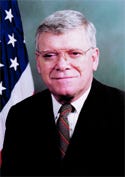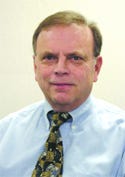Capitol Hill Questions Device Safety
Originally Published MDDI April 2006 Washington Wrap-UpAs FDA remembers its own founding, Congress discusses new device concerns. James G. Dickinson
April 1, 2006
Washington Wrap-Up
|
In the same week that a congressional hearing raised concerns about reprocessed single-use devices being sold on eBay without regulatory constraint, FDA posted on its Web site an article on its history and modern mission. The article recalled FDA's founding by Theodore Roosevelt in a 1906 bid to “save capitalism by civilizing it.”
Written by noted author and former New York Times reporter Philip J. Hilts, the article is called “The FDA at Work: Cutting-Edge Science Promoting Public Health.” It gives a broad historical base for FDA's present role and immediate challenges. It discusses the nation's Founding Fathers, who wrote a Constitution that did not foresee the Industrial Revolution; Abraham Lincoln, who was “aghast” at the advent of industrial corporations; and Roosevelt's revolutionary agenda.
Looking to the future, FDA acting commissioner Andrew von Eschenbach had referred to the 21st century device industry as a “Wild West medicine show” that same week. The reference came during an appearance before the House Appropriations Subcommittee on Agriculture, Rural Development, FDA, and Related Agencies on February 16.
|
Representative Rosa DeLauro noted that the number of conflict-of-interest waivers FDA issues seems excessive. |
Representative Rosa DeLauro (D–CT) questioned von Eschenbach about the safety of reprocessed medical devices. She said her staff had recently identified a total of 1056 items of used surgical equipment advertised for sale on eBay. Von Eschenbach blandly replied that CDRH is aware of potential problems associated with reuse of medical devices. He also noted that reprocessors should be treated as manufacturers and that FDA is developing guidances to that end.
DeLauro also challenged von Eschenbach on the frequency of conflicts of interest among FDA advisory committee members—or the appearance thereof. She noted the agency has issued 55 conflict-of-interest waivers for committee members since last November. That number, she said, seems excessive, especially compared with the experience of the National Institutes of Health with its committee members. Von Eschenbach left without ceding any of her points, leaving himself open to further interrogation on these as well as other issues during his confirmation hearings for permanent FDA commissioner.
Bush Budget Focuses on Safety, User Fees
Conventional wisdom inside the Beltway characterized President Bush's FY 2007 federal budget request as a pipe dream. However, the request included FDA provisions that are likely to survive. Among the provisions are a hike in medical device user fees, and $6.4 million to improve device safety.
Less certain is $22 million for a new user-fee provision. It would be paid by companies that must be reinspected after failing to meet CGMP or other critical FDA regulations.
Kathleen Heuer, HHS associate commissioner for management, said the agency believes violative firms should bear the cost of reinspections, rather than American taxpayers. She spoke at a news conference in February, saying that legislation authorizing the new user fee was sent to Congress on February 6. So far, no sponsors have been identified, and there is no indication of how quickly it could be passed. The budget request assumes the user fee would take effect October 1.
Heuer also said the overall budget request totals $1.95 billion, a 3.8% increase over FY 2006. It includes $1.55 billion in budget authority and $402 million in industry user fees.
Officials said the proposed $70.8 million increase would allow FDA to focus on priority initiatives, such as preparing for the threat of a flu pandemic and protecting the food supply from bioterrorism. Other goals include realizing the promise of molecular medicine, strengthening safety of drugs and human tissues for transplantation, and meeting statutory obligations under the medical device user fee programs.
Heuer said there are some 1300 reinspections annually and the estimated cost, based on historical data, is $22 million. She explained that the agency is still working on a fee schedule proposal, so it is not possible to estimate what companies of various sizes or with various violations might have to pay. She noted that FDA expects the user fee to be an incentive to companies to eliminate potential violations. The ultimate effect would be that firms would end up with safer products. “We expect that manufacturers would move judiciously to meet the standards to avoid costly downtime,” she said.
Other highlights of the proposal include $5.9 million for the Critical Path for Personalized Medicine initiative. That plan includes medical imaging for use as cancer trial surrogate endpoints, cardiac drug-eluting stent design, and an ECG warehouse.
|
Lester Crawford has joined a firm that lobbies for healthcare and biotech issues. |
Crawford Joins Lobbying Firm
Former FDA commissioner Lester Crawford has joined Policy Directions Inc. (PDI), a Washington lobbying firm that is active on behalf of healthcare, pharmaceutical, and biotech companies. PDI's senior vice president, Steve Kopperud, said Crawford joined the firm “in early January as full-time senior counsel.” He declined to comment on Crawford's specific responsibilities or accounts. He also did not comment on whether Crawford would appear before FDA once his moratorium against lobbying the agency ends. At presstime, Crawford had not replied to a request for an interview.
According to the U.S. House of Representatives Office of the Clerk Web site, PDI's clients include two device firms: Baxter Healthcare and Bausch & Lomb.
Crawford unexpectedly resigned from FDA last September, shortly after he was confirmed by the Senate. There have been reports that questions were raised about stock dealings he and his wife had with drug companies. The Senate Health, Education, Labor, and Pensions Committee asked the HHS Inspector General to look into the nomination and resignation. It has yet to receive a report from the agency.
Mandatory Device IDs Sought
CDRH officials are not sure they can justify proposing a mandatory regulation for unique identification of medical devices. However, stakeholders at an FDLI meeting in October were consistent in their belief that it would improve patient safety and supply-chain efficiency.
Following the session, nine organizations that were represented there submitted additional comments. Their comments stressed the consensus within the provider community on this issue. “Our organizations support mandatory unique identification of medical devices, as the transmission and translation of critical data has vast potential for improving patient safety and supply-chain efficiency.”
A compelling patient safety interest lies in requiring identification technology for certain medical devices, including implantable items, they said. Such items include hip and knee prosthetics, stents, and cardiac rhythm management pacers. Unique identification technology would facilitate and improve the tracking of these devices, especially in the event of a recall or other safety concern. It also can improve risk management through reductions in supply-chain and medical errors, the firms said. Inventory, warehousing accuracy, and product movement efficiency could be improved, thereby reducing operating costs.
The organizations noted that hospitals are already adopting this technology. But the lack of a national standard means they are investing millions of dollars to create internal tracking systems for devices. “It is clear this investment improves quality and supply-chain efficiency for the hospital, but a national unique identifier system would accelerate these efforts that ultimately benefit patients,” they said.
The meeting allowed stakeholders to provide information to CDRH on four issues:
• The kinds of information that could be readily captured in such a system.
• The kinds of identification technologies that could be employed.
• The advantages and disadvantages of such systems, including patient safety implications.
• The major bar coding systems and device nomenclature systems that are being used by the medical device community.
|
Kevin L. Cornwell feels disappointed that FDA officials will not admit any wrongdoing. |
HHS Denies Utah Medical's Claim
HHS in February formally denied Utah Medical Products' administrative claim for tortious abuse of process by FDA employees. HHS said the claim was “not cognizable under the [Federal Tort Claims Act].” The denial came nearly a full month after the legal deadline for the response.
In a statement, Utah Medical said it remains convinced the claim is valid. The firm noted that it is “now is free to file suit against FDA in the federal district court, or file a request for reconsideration, before August 10, 2006. The company will carefully consider all of its options.”
The statement quoted CEO Kevin L. Cornwell as saying, “We were hoping that independent and objective representatives of the executive branch of government would have been assigned to investigate this claim and be willing to discuss a constructive settlement with Utah Medical.” Such a settlement, he continued, would include restoring the device firm's reputation for manufacturing high-quality products. It would also rectify a permanent public record that incorrectly disparages the firm. Finally, he noted, a settlement would repay the firm's “unnecessary costs of litigation” that resulted because FDA would not open a dialog regarding Utah Medical's responses to what they considered predetermined inspectional observations. “It continues to be disappointing that officials in our government prefer to hide than to admit any wrongdoing,” Cornwell's statement continued.
Cornwell went on to say that “there is much more of a story here of systemic corruption than has been publicly disclosed to date. Fraud is not included in the discretionary function privilege of the government.”
Boston Scientific Warned over Quality
In early February, Boston Scientific executives met with CDRH director Daniel Schultz and top FDA compliance officials about its GMP/QSR problems. Afterwards the executives said the discussions had been “productive.” They and FDA agreed on a commitment to resolving, in FDA's words, “all issues according to an aggressive timeline.” An agency news release said the company “acknowledged FDA's assessment of corporate-wide quality system and device reporting deficiencies.”
A company statement said, “We reviewed with FDA a path to resolve the issues it has identified, and we are committed to working closely with it to ensure they are resolved.” For its part, FDA said it was committed to responding to all questions, plans, and scheduling of verification inspections in an equally timely manner.
The meeting followed a January 25 warning letter. In the letter, FDA New England district director Gail T. Costello told the company that corrections it had previously promised on GMP and QSR deficiencies were inadequate “spot fixes.” It said the firm failed to achieve the necessary systemic approach to comprehensively address the violations. The letter's unusually tough wording suggested FDA had lost patience with the company. It ordered Boston Scientific to “take action on this matter now” to ensure that an effective quality system was put in place and demanded a “prompt meeting.”
Boston Scientific's Violations The warning letter targeted three recent facility inspections: Natick, MA; Maple Grove, MA; and Spencer, IN. It came on the heels of three separate warning letters last year. During the inspections, the letter said, FDA found recurring deficiencies noted in previous letters. “FDA has found ongoing systemic violations in the quality management system employed to ensure the safety and effectiveness of the medical devices you distribute,” it said. Violations cited in the letter include the following: • Failure to review the suitability and effectiveness of the quality system at defined intervals. • Failure to review, evaluate, and investigate any complaint involving the possible failure of a device. • Failure to establish and maintain procedures for receiving, reviewing, and evaluating complaints. • Failure to promptly review, evaluate, and investigate complaints that are MDR reportable. • Failure to establish and maintain procedures for implementing corrective and preventive actions. • Failure to report within 30 days information that suggests a device may have caused or contributed to a death or serious injury. |
“For this meeting, you should come prepared to discuss your current corporate strategy to bring all of your facilities into compliance,” Costello wrote. “You should also come prepared to discuss the recent recalls at your facilities and your ongoing corporate efforts to prevent the recurrence of these violations.”
The letter documented a number of MDR reporting issues where the firm failed to report certain events associated with its drug-eluting stents or where it was late in reporting. In one instance, it said, the firm was up to 366 days late. Also, it said, two “correction or removal” recall actions were not reported and were erroneously classified as Class III recalls. They should have been classified as the more serious Class II.
A statement by Boston Scientific noted that the warning letter primarily focused on product complaint issues related to corporate review, analysis, and reporting. “FDA does not plan to advise hospitals to discontinue using the products referenced in the letter, including the Taxus system,” it said. The company recently established a new global complaint information system to help address the issues raised in the warning letter. It has also launched a global, cross-functional initiative to improve and harmonize its overall quality systems.
Copyright ©2006 Medical Device & Diagnostic Industry
About the Author(s)
You May Also Like




.png?width=300&auto=webp&quality=80&disable=upscale)

